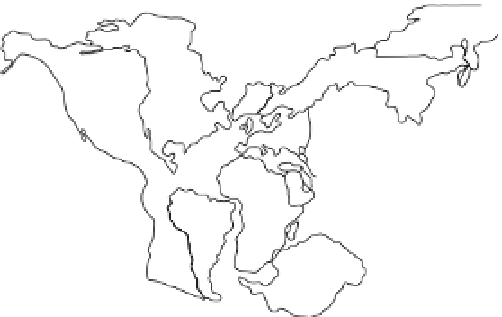Geoscience Reference
In-Depth Information
plumes, but they are a natural part of plate
tectonics.
Most of the continental areas were above
sea level from the Carboniferous and Permian
through the Triassic, at which time there was
subsidence in eastern North and South America,
central and southern Africa, Europe and Arabia.
The widespread uplift, magmatism, breakup and
initial dispersal of the Pangean landmass appar-
ently occurred while the continents were cen-
trally located with respect to the present geoid
anomaly, assuming that it is long-lived. The sub-
sequent motions of the plates, by and large, were
and are directed away from the anomaly. This
suggests that the residual geoid high, hotspots,
the distribution of continents during the late
Paleozoic and early Mesozoic, and their uplift
and subsequent dispersal and subsidence are all
related. The shields have abnormally thick, cold --
but buoyant -- keels. The high viscosity and low
thermal expansion of the lower mantle, and
the relatively small amount of radioactive and
core heating, means that the features responsible
for the long-wavelength geoid are probably very
long-lived.
At 100 Ma Europe, North America and Africa
were relatively high-standing continents. This
was after breakup commenced in the North
Atlantic but before significant dispersal from
the pre-breakup position. North America suf-
fered widespread submergence during the Late
Cretaceous while Africa remained high. Europe
started to subside at about 100 Ma. This is con-
sistent with North America and Europe drift-
ing away from the center of the geoid high
while Africa remained near its center, as it does
today.
Horizontal temperature gradients can drive
continental drift. The velocities decrease as the
distance increases away from the heat source and
as the thermal anomaly decays. Thick continen-
tal lithosphere then insulates a new part of the
mantle, and the cycle repeats. Periods of rapid
polar motion and continental drift follow periods
of continental stability and mantle insulation.
The relationship between surface tectonic fea-
tures and the geoid changes with time. Super-
continents periodically form and insulate the
Fast
Fast
Fast
Fast
Subducted
Oceanic
Lithosphere
Fast
Fast
Fig. 6.4
Reconstruction of the continents and their motion
vectors at about 110 Ma. The hatched areas represent former
oceanic lithosphere. These regions, in general, have high
seismic velocities in the transition region, consistent with the
presence of cold subducted lithosphere. They are also, in
general, geoid lows. Dots represent possible convergence
areas.
underlying mantle and also control the locations
of mantle cooling (subduction zones). When the
continent breaks up, the individual fragments
move away from the hot part of the mantle and
the geoid high, and come to rest over cold man-
tle, in geoid lows. Large long-lived oceanic plates
can also insulate the mantle, generating broad
topographic swells.
The locations of hot and cold regions in the
upper mantle may also be influenced by thermal
anomalies in the lower mantle. The lower mantle
contribution to the geoid is probably long-lived.
Empirically, subduction zones and continents
are primarily in long-wavelength geoid lows and
over long-wavelength fast seismic regions of the
lower mantle. This can be understood if conti-
nents come to rest in geoid lows and if sub-
duction zones, on average, are controlled by the
advancing edges of continents. Midocean ridges
tend to fall between the long-wavelength highs
and lows. By long wavelength, we mean features
having dimensions of thousands of kilometers.
Figure 6.4 shows the approximate locations
of the continents just after breakup of Pangea
commenced. The hatched regions show oceanic
lithosphere
that
has
been
overridden
by
the









































